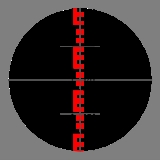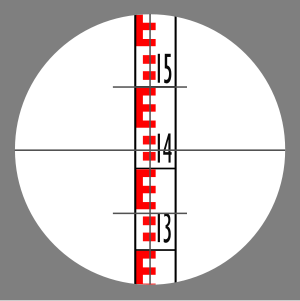
Stadia mark
Encyclopedia
Stadia marks, also called stadia lines or stadia hairs, are crosshairs on the reticle of a theodolite
or other surveying
instrument that allow stadiametric rangefinding.
 A typical surveyor's instrument reticle has two pairs of stadia marks. One pair are on the horizontal centreline and the other on the vertical. Each functions in the same manner and are placed for measuring on either axis.
A typical surveyor's instrument reticle has two pairs of stadia marks. One pair are on the horizontal centreline and the other on the vertical. Each functions in the same manner and are placed for measuring on either axis.
The stadia marks are set a specific distance apart. The distance is chosen so that there is a fixed, integer ratio between the distance observed between the marks and the distance from the telescope to the measuring device observed. This is known as the stadia constant or stadia interval factor. For example, a typical stadia mark pair are set so that the ratio is 100. If one observes a stadia rod, rule or levelling rod with the telescope and sees that the rod spans 0.5m between the marks (the stadia interval), then the distance from the instrument to the rod is:
In the image to the right, the upper stadia mark is at 1.5 m and the lower at 1.345 m. The difference is 0.155 m. Thus the distance from the instrument to the levelling rod is:
Theodolite
A theodolite is a precision instrument for measuring angles in the horizontal and vertical planes. Theodolites are mainly used for surveying applications, and have been adapted for specialized purposes in fields like metrology and rocket launch technology...
or other surveying
Surveying
See Also: Public Land Survey SystemSurveying or land surveying is the technique, profession, and science of accurately determining the terrestrial or three-dimensional position of points and the distances and angles between them...
instrument that allow stadiametric rangefinding.
Etymology
The term stadia mark derives from the obsolete unit of distance, the stadia. There were several different stadia defined such as the Greek stadia and Egyptian stadia.Usage

The stadia marks are set a specific distance apart. The distance is chosen so that there is a fixed, integer ratio between the distance observed between the marks and the distance from the telescope to the measuring device observed. This is known as the stadia constant or stadia interval factor. For example, a typical stadia mark pair are set so that the ratio is 100. If one observes a stadia rod, rule or levelling rod with the telescope and sees that the rod spans 0.5m between the marks (the stadia interval), then the distance from the instrument to the rod is:
- 0.5m x 100 = 50 m.
In the image to the right, the upper stadia mark is at 1.5 m and the lower at 1.345 m. The difference is 0.155 m. Thus the distance from the instrument to the levelling rod is:
- 0.155 x 100 = 15.5 m.
See also
- Stadiametric rangefinding
- TacheometryTacheometryTacheometry , is a system of rapid surveying, by which the positions, both horizontal and vertical, of points on the earth surface relatively to one another are determined without using a chain or tape or a separate levelling instrument....
- TheodoliteTheodoliteA theodolite is a precision instrument for measuring angles in the horizontal and vertical planes. Theodolites are mainly used for surveying applications, and have been adapted for specialized purposes in fields like metrology and rocket launch technology...
- Dumpy levelDumpy levelA dumpy level, builder's auto level, leveling instrument, or automatic level is an optical instrument used to establish or check points in the same horizontal plane...
- Plane tablePlane tableA plane table is a device used in surveying and related disciplines to provide a solid and level surface on which to make field drawings, charts and maps...
- Levelling rod

